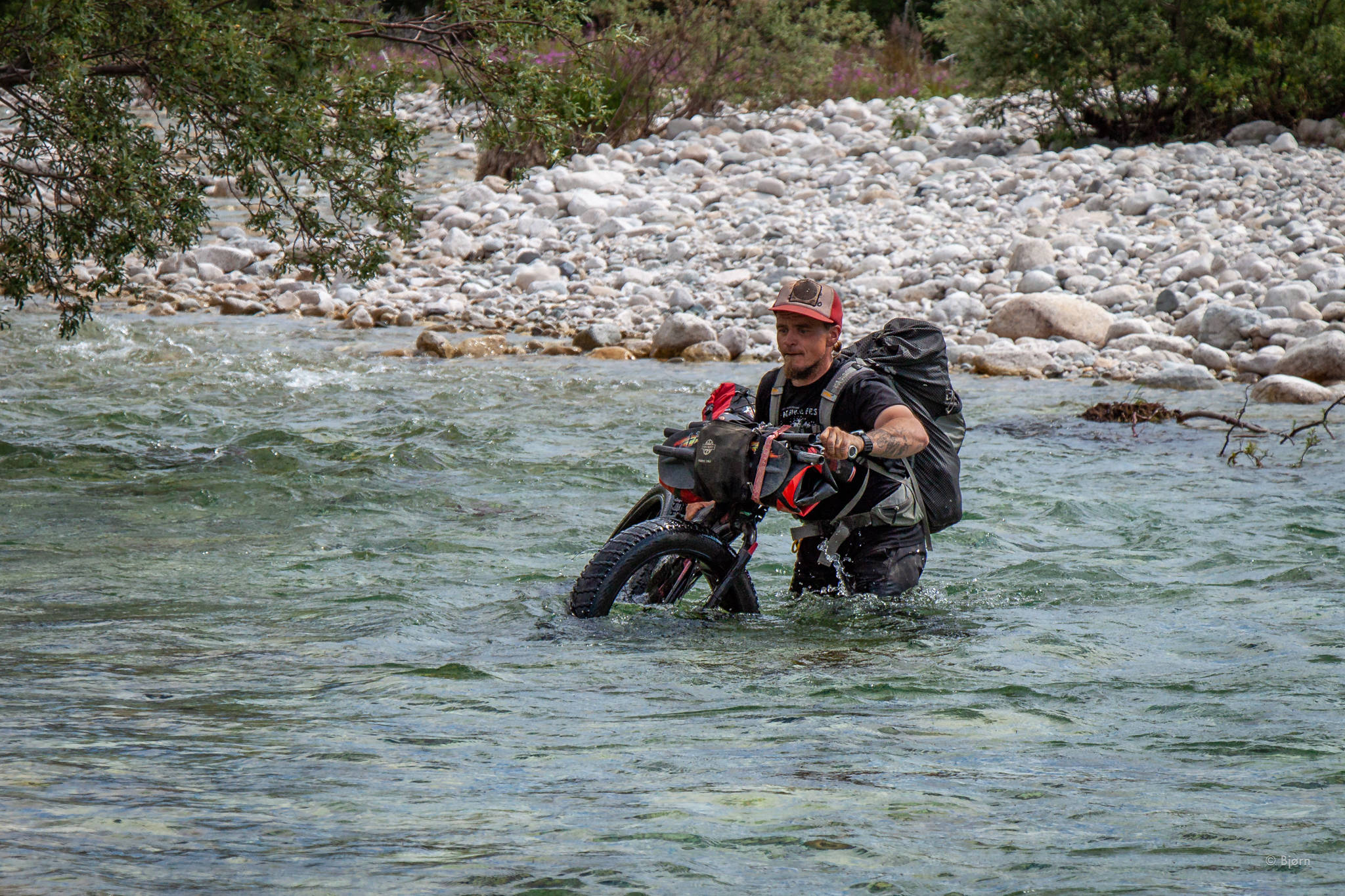In 2013, Bjørn Olson decided to fatbike and packraft from Cook Inlet to Bristol Bay via the northern shore of 77-mile long Lake Iliamna. He joked — well, it might not entirely be a joke — that he was looking for the lake’s famed monster.
“We met a few folks along the way who 100 percent believe they’d seen it. They wouldn’t hear anything about it being some giant sturgeon. We started out hoping to see the Illimani lake monster, but I’m kind of convinced the monster is the lake itself,” Bjørn said.
Bjørn grew up in the shadows of the Wrangell Mountain Range in the tiny village of Slana. His dad worked as a hunting guide and his family lived a homesteading lifestyle. It was there amidst the rugged country that his appreciation of, and penchant for exploring, the wilds of Alaska was born. These days, Bjørn is based out of Homer and known across the state as a thoughtful and hardcore explorer. His favorite modes of travel are fatbiking and packrafting. Fatbikes, with their oversized tires, are designed for riding across snow, sand and in other conditions where normal mountain bikes would get bogged down. Packrafts, which weigh around seven pounds and, when deflated, roll up to about the size of a sleeping bag, have redefined what’s possible in backcountry travel. Many Alaskans love their packrafts and fatbikes more than their sweethearts, children or, even, dogs. There’s talk of starting a rehabilitation center for victims of this outdoor phenomenon but, the sad truth of it is there’s no coming back once you cross into that world.
[New book offers nuanced look at how humans and bears get along]
Bjørn is a talented filmmaker, photographer and writer. He’s on the board of the Kachemak Bay Conservation Society and works with the United Tribes of Bristol Bay and Ground Truth Alaska, formally known as Ground Truth Trekking. The latter is a nonprofit that utilizes human-powered exploration and scientific analysis of areas where large scale industrial projects are being proposed. Bjørn’s work, with a heavy emphasis on adventuring, focuses on environmental and social issues in Alaska—which for a lot of folks are one and the same. For instance, practicing subsistence is an important part of the fabric of much of Alaska and, to do so, requires healthy ecosystems.
In 2013, when Bjørn decided to travel from Cook Inlet to Bristol Bay, he did so largely to learn more about the proposed Pebble Mine and what was at stake if the project were ever to be developed. Seeing the Iliamna Lake monster would be bonus material. The journey took 10 days and covered 250 miles.
“Our timing was perfect. It was a hot July. My goal was to ride as much as was possible,” Bjørn said.
He and his partner, Brent, hitched a ride on a landing craft to Iliamna Bay in Cook Inlet and the beginning of the Pile Bay-Williamsport Road. The 15-mile gravel road offers a shorter route for commercial fishing boats to get to Bristol Bay than motoring all the way around the Alaska Peninsula. Travel quickly became interesting once the two men left the road. Brown bear signs were everywhere and sockeye salmon were busy spawning.
“All the sockeye were blushed out and the streams were chock full. It was incredible. The lake is this massive nursery that supports Bristol Bay,” Bjørn said.
The first leg of the journey demanded creative route finding. Sometimes to save time, the two men would swim with their bikes around cliffs along Lake Iliamna’s shore. Their packrafts were invaluable.
“It’s incredible to have the ability to roll up your completely competent watercraft and strap it to your handlebars or stuff it in your backpack. To have that versatility to be able to move through huge swaths of Alaska territory—it’s unparalleled,” Bjørn said.
After a few days of creative route finding, Bjørn and Brent were able to ride their fatbikes pretty consistently along Lake Iliamna’s shore. They were treated with hospitality and met great people in the handful of Native villages they passed through. The last leg of the trip involved packrafting down the Kvichak River. The 50-mile long Kvichak, which empties into Bristol Bay near Naknek, is considered to be the river with the biggest salmon run in the world. It’s also just downstream of where the Pebble deposit is located. Paddling the Kvichak started off well for Bjørn and Brent but, when they got to the lower stretches of the river, headwinds and tidal variations proved challenging. At that point in the Bjørn made about the trip, he had to contend with his inner Gollum to get through what he called “the Blair Witch part of the Expedition.”
Seven years later, Bjørn still raves about the trip even though he didn’t see the monster. When asked about the current state of Bristol Bay and surrounding region, Bjørn says there’s a lot to celebrate with Army Corps of Engineers on Nov. 25 of last year.
“We need permanent protections, though. The next fight is for permanent protections for the region,” Bjørn said.
Check out Bjørn’s work on his website mjolnirofbjorn.com and follow him on Instagram @fatbikebjorn.
• Pride of Bristol Bay is a free column written by Bjorn Dihle and provided by its namesake, a fisherman direct seafood marketer that specializes in delivering the highest quality of sustainably caught wild salmon from Bristol Bay to your doorstep. It appears monthly in the Juneau Empire.

